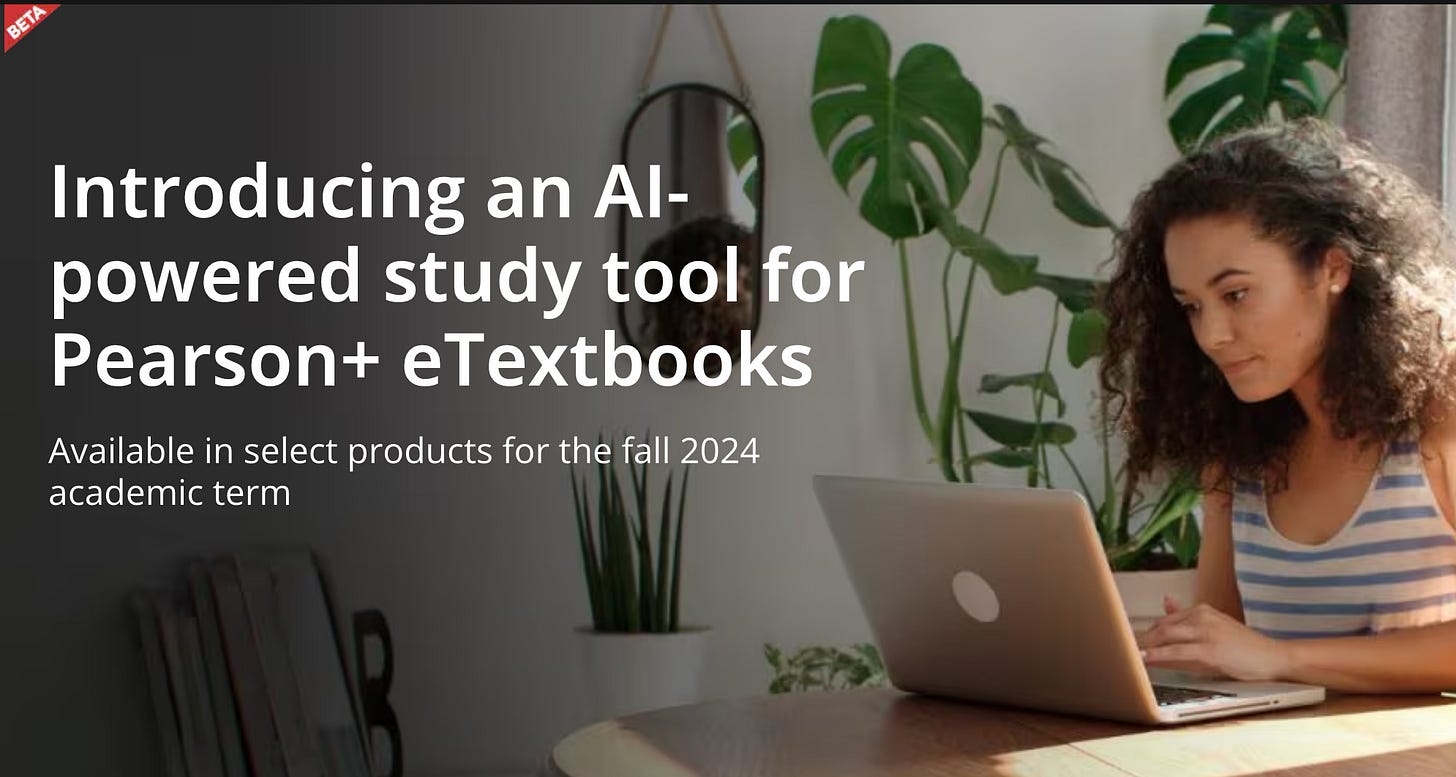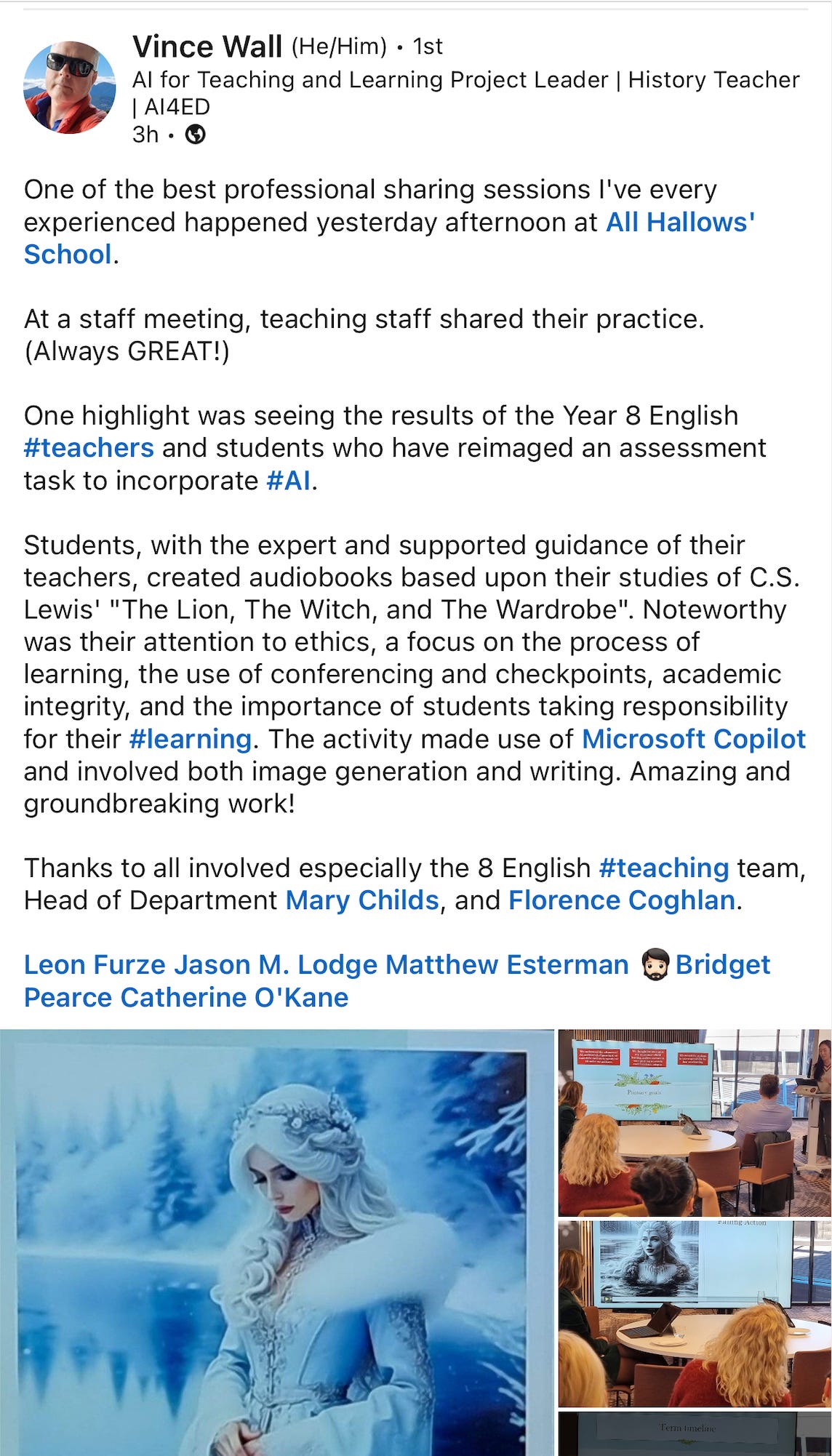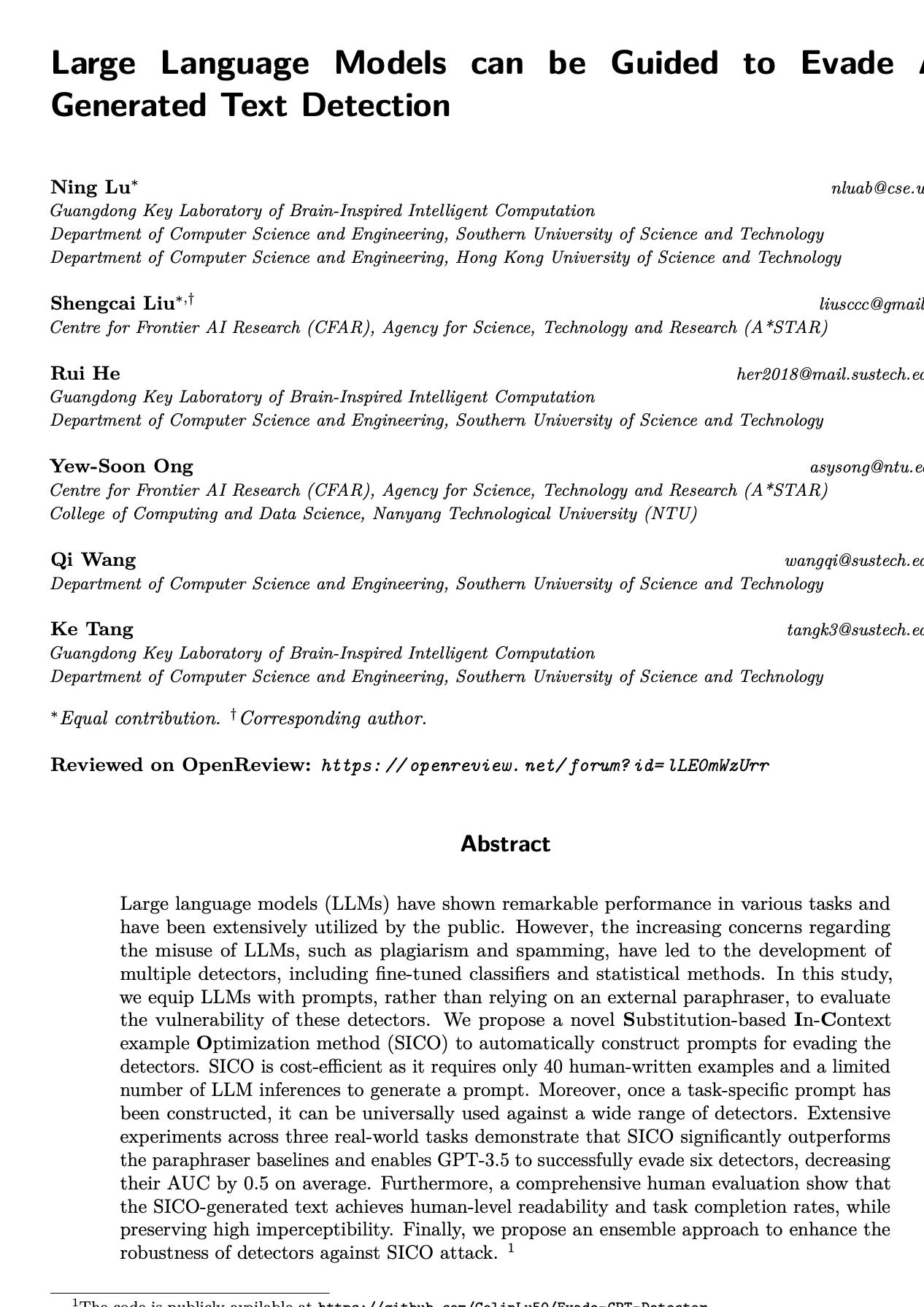11 Summer AI Developments Important to Educators
Equity demands that we help students prepare to thrive in an AI-World
*SearchGPT
*Smaller & on-device (phones, glasses) AI models
*AI TAs
*Access barriers decline, equity barriers grow
*Claude Artifacts and Projects
*Agents, and Agent Teams of a million+
*Humanoid robots & self-driving cars
*AI Curricular integration
*Huge video and video-segmentation gains
*Writing Detectors — The final blow
*AI Unemployment, Student AI anxiety, and forward-thinking approaches
*Alternative assessments
Thanks to everyone who has supported this blog with a paid subscription! [our book]
____
The focus of this post is on some of the larger developments that will have an impact on education this fall. Given the rapid rate of development, it is critical that schools help prepare students for this emerging AI world. Equity demands nothing less.
*AI-integrated search in ChatGPT and more. Perpexity.ai is a semantic search tool that combines generative AI with web search. It still has some hallucinations, but in my daily usage, I’d estimate that hallucinations went from around 30% to less than 5% over the year.
So, yes, it can write student papers and insert the sources. Based on my experience, these are stronger/of higher academic quality than the sources one can find through a basic Google search, which tends to throw a lot of paid results. Recently, it implemented a revenue sharing program with publishers.
Many students are not familiar with Perplexity, so this has limited its impact on school essays, but ChatGPT, which most are familiar with, is currently testing a similar product — SearchGPT.
This is how this works in Perplexity.
SearchGPT is similar, but it also produces video explainers. Students are used to interacting with video, so this is one way it can enhance learning.
*Smaller & local, on-device models. Smaller and smaller models have been released. This means AI tools are moving onto devices such as phones, glasses, and soon, even contact lenses.
On Monday, July 29, Apple provided developers with the first betas of iOS 18.1, iPadOS 18.1, and macOS Sequoia 15.1, with the new software introducing an early version of the Apple Intelligence features. An iPhone 15 Pro or iPhone 15 Pro Max, or an iPad or Mac with an Apple silicon chip is required to use Apple Intelligence, and only eligible devices will see the updates. [See the paper for more details if you are interested]
The moves Writing Tools on-device. With Writing Tools, you can rewrite, spellcheck, grammar check, and summarize text in Messages, Notes, Mail, Pages, and other apps where you write. Summaries also work for transcripts in the Notes app.
Students will also be able to record classes and get summaries.
Meta glasses, which are available with prescriptions, have a lot of tools that will help students throughout the day.
Meta is just one brand of these glasses.
*AI TAs. This is more of a university thing so far, but more and more AI TAs are emerging.
A recently released study from professors at the University of Pennsylvania found AI TAs are equivalent to human TAs in most instances.
Similar “bots” are now available in leading textbooks.
Teachers can create similar tools by building GPTs or using applications such as playlab.ai. I think that by the fall of 2025, these type of textbook AI assistants will be a part of K-12 curriculum packages.
*Access barriers decline, and equity concerns remain. Free versions of the most advanced AI tools (ChatGPT-4o; Claude Sonett 3.5; Meta (powered by Llama 3 405B, which is free for the world to use) are now available through apps on cell phones.
[Note: the smaller models that are “local/on-device” have fewer capabilities than the larger models, but the larger models are still accessible through apps on phones]
Ninety-five percent of US teens have phones. They can access very good AI. In many cases, what they can access for free will be better than what any school can provide due to FERPA, COPPA, etc. restrictions that may limit the products.
We do need to worry about access for the remaining 5%, but the real issue is equity, not access. How to communicate with AIs, how to manage teams of AIs, how to build/train your AIs for specific tasks (AIs with “personas”), how to talk about AI in a conversation, how to use debate between AIs to reduce hallucinations, etc. are all essential skills for the future.
Many students are starting to learn about these things in school and others spent the summer learning about them at camps.
In the near future, all of our digital interactions will be mediated by AIs, and those that can best take advantage of that will be in the best position to succeed. It’s almost inconceivable that those who cannot take advantage of AIs will be able to thrive.
*Claude Projects & Artifacts. Claude 3.5 is now available for limited free use and has both Artifacts and Projects (Projects does require a $20 monthly subscription).
I’ll have more on these later this week. For now, Dan Fitzpatrick has a quick write-up.
Beyond FERPA, COPPA, etc. compliance, and a dashboard, tools like this leave one wondering what distinguishes an “ed tech” AI product from any other AI tool.
And while teachers may be building curriculum with it, 8-year-olds are building games.
*Agents and Teams of Agents. AI agents are autonomous software programs designed to perceive their environment, make decisions, and take actions to achieve specific goal.
AI agents are autonomous software programs designed to perceive their environment, make decisions, and take actions to achieve specific goals. Autonomy allows AI agents to perform tasks without constant human intervention. They can sense and interpret their environment through various inputs, assess and respond to changes, analyze data to make informed decisions, improve their performance over time through machine learning techniques, and interact with other agents or humans using various methods.A
The evolution of AI is now moving towards models that incorporate thousands, and potentially millions, of agents working in concert.Multi-agent systems involve numerous AI agents collaborating or competing to solve complex problems, mimicking real-world scenarios where multiple entities interact, leading to more sophisticated and realistic AI solutions.
By utilizing multiple agents, AI systems can tackle increasingly complex tasks and environments. Each agent can specialize in a specific area, contributing to a more comprehensive and nuanced approach to problem-solving.
Large-scale multi-agent systems can exhibit emergent behavior, where the collective actions of many agents lead to complex, system-level outcomes that are not explicitly programmed. With a diverse array of agents, these systems can adapt more effectively to changing environments and unforeseen circumstances. Multiple agents can share knowledge and learn from each other's experiences, potentially accelerating the overall learning process of the AI system.
As we move towards models with thousands or millions of agents, we are approaching a level of AI sophistication that more closely resembles the complexity of human societies and ecosystems.
For educational institutions, the integration of AI agents could revolutionize the way education is delivered and managed. AI agents can personalize learning experiences for students by adapting to their individual learning styles and paces, providing real-time feedback, and offering tailored resources. They can also assist educators by automating administrative tasks, grading, and even providing insights into student performance and areas that need attention. Furthermore, multi-agent systems could facilitate collaborative learning environments where AI agents support group work, simulate real-world scenarios, and enhance problem-solving skills among students.
Schools that are looking to purchase “AI apps” should look in this direction.
*Humanoid robots. There have been very significant advances in humanoid robots, with today’s AI models essentially acting as the “brains” of the robots.
We are also now in a period where robots are starting to develop robots. Companies like Nvidia are at the forefront of this innovation with initiatives like the "Factory of the Future," where AI-powered robots are used to build and train other robots. This advancement has the potential to revolutionize manufacturing processes. Simultaneously, robotics is expanding into new sectors beyond traditional manufacturing, including healthcare, agriculture, retail, and construction.
One particular manifestation of robots is self-driving cars, which have driven more than 40 million miles.
As explained in his new book, This Time It’s Different, NASA’s Chief AI Officer, Dr. Omar Hatamleh, living with robots, including humanoid robots, present challenges to the social fabric that we all must manage. Students need experience working with robots. All of our students will now graduate into worlds infused with robots.
AI curricular integration. More and more schools are making significant efforts to integration AI/emerging technology instruction into the curriculum.
These are good examples of why I think equity is so important. Access to what is above is available to most people. Learning how to take advantage of the technology is not.
Generative AI video and related advances. Generative AI video has really taken off, with programs such as runway.ml available to consumers. These videos are entirely AI generated
Meta also recently released SAM-2, an advanced model designed for both image and video segmentation, using a unique architecture that combines transformer technology with a memory mechanism to track and segment objects across video frames.
This allows it to maintain continuity even in challenging situations like fast movements or when objects are partially hidden. A key feature of SAM 2 is its zero-shot learning capability, enabling it to recognize and segment new object categories without needing special training, making it adaptable for various visual tasks. Users can interact with the model by providing prompts like clicks or bounding boxes, which helps refine the segmentation results.
SAM 2 also boasts impressive performance, requiring three times fewer interactions for video tasks and operating at about 44 frames per second, making it suitable for real-time use. It was trained on the extensive SA-V dataset, which includes around 51,000 videos and over 600,000 mask annotations, ensuring high-quality training. Overall, SAM 2 is a significant step forward in computer vision, offering powerful tools for applications ranging from video editing to robotics, and its open-source release encourages further innovation in segmentation technology.
Writing detectors — stop the madness. As AI writing becomes more human an individualized, AI writing detectors have become more and more useless.
A new prompting technique can also be used to defeat them.
Here are three webinars if you are still confused.
And as this post demonstrates, a lot more is at-stake than whether students write papers with AI.
Student uncertainty and unemployment. As AI technology continues to advance and become increasingly prevalent in everyday life, students are growing more uncertain about their future in an AI-driven world.
A 2023 Junior Achievement Survey found that 66 percent of teens are anxious about finding a job in the future due to artificial intelligence. However, research suggests that schools can play a significant role in alleviating these concerns and preparing students for success in an AI-driven world.
By integrating AI into education and teaching critical and creative thinking, resilience, flexibility, curiosity, and lifelong learning, schools can help students develop the skills they need to adapt to this new reality.
In fact, a 2024 poll conducted for the Walton Foundation found that the popularity and use of AI in education are rising rapidly among students and teachers, with many schools already seeing the positive impact of AI integration on students' lives and attitudes.
By starting to prepare students for an AI-driven world, schools can have a big impact on students' lives and attitudes, helping them feel more confident and prepared for the future.
*Alternative assessments. More and more schools are investing in alternative assessments and training. n an increasingly AI-driven world, alternative assessments such as project-based learning, debate, and portfolios are essential in fostering the skills students need to thrive. Traditional assessment methods often emphasize rote memorization, which falls short in preparing students for real-world challenges. In contrast, project-based learning promotes critical thinking and problem-solving by engaging students in authentic tasks that reflect real-world scenarios. Similarly, debate encourages the development of communication skills and the ability to think on one's feet, while portfolios allow for the demonstration of a student's growth and individualized learning journey.
















